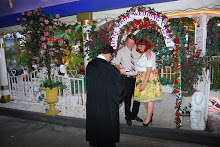
From the Ohio Department of Rehabilitation and Correction's website, on the history of the Ohio Penitentiary: "
Built in 1834, the Ohio Penitentiary was actually the second Ohio Penitentiary, the third state prison, and the fourth jail in early Columbus. In April 1955 it housed an all-time high of 5,235 prisoners. Most prisoners were removed from the prison by 1972 with the completion of the Southern Ohio Correctional Facility, and the facility was closed in 1984. The state sold the Ohio Penitentiary to the City of Columbus in 1995.
Much debate surrounded the future of the Ohio Penitentiary. When thoughts turned to demolishing the penitentiary, the preservationist community mounted a campaign to save at least five historic buildings on Spring Street. However, that effort failed and the Ohio Pen was demolished, with the exception of some sections of the Pen's limestone facade, which were dismantled for possible reuse.
The City of Columbus leased the grounds to Nationwide Mutual Insurance and the Dispatch Printing Co. The 23-acre site, bounded by Maple, West and Spring Streets and Neil Avenue, is now a 1,000 car parking lot for the $125 million Nationwide Arena next door."
I remember driving past the Ohio Pen a lot as a kid. It was always empty, as it had closed the year I was born. But it was always an intriguing building, and I really always felt compelled towards it every time I passed it. I feel that if it was still around now, it's something I would photograph often. But, it was torn down when I was still in high school, before I was interested in doing what I do now. One thing I always found fascinating was that my mom once told me how in the the Ohio Pen was a popular destination for school field trips, as my grandmother had experienced when she was in school (not sure what grade). It was kind of a way to scare kids straight from crime. Anyways, I'd like to compile some more info on this prison at the library, but theres more great photos on Columbus In Historic Photographs here, http://www.columbuslibrary.org/cmlohio/photohome.cfm. Just type in Ohio Penitentiary in the search box. The location was Spring and Neil Sts. More info to come.















